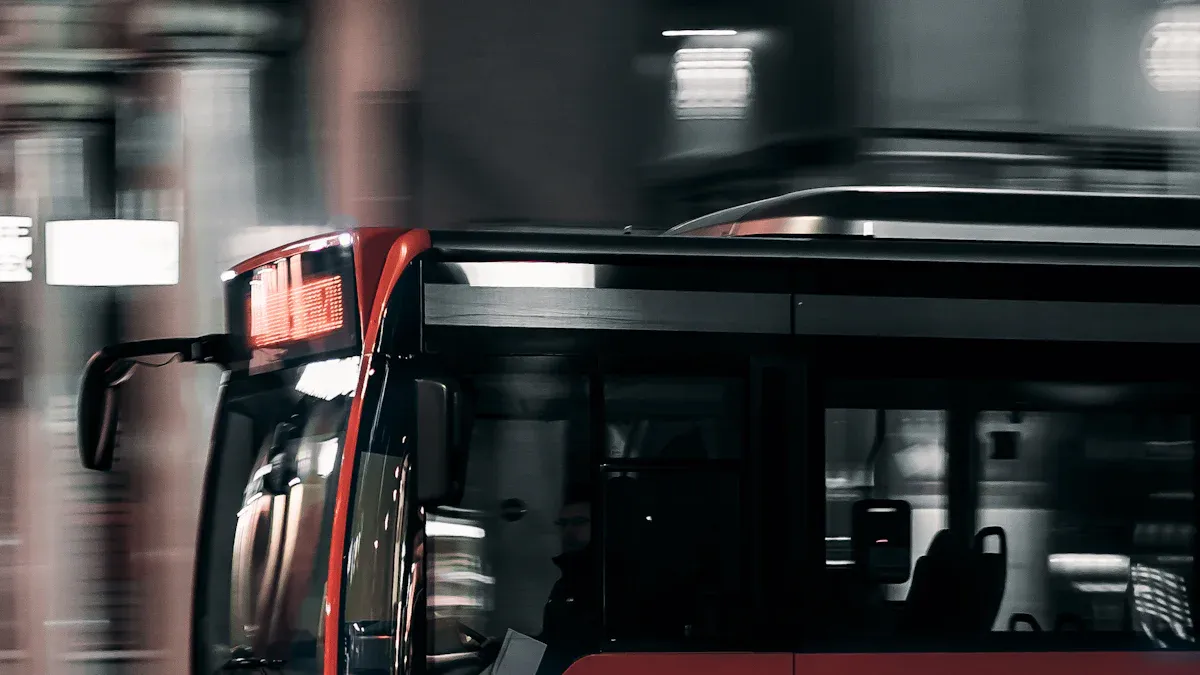
Bus advertising is a kind of out-of-home advertising. It uses public and private buses to show branded messages to people. When you put ads on buses, your message moves through busy streets and neighborhoods. This gives your brand a lot of attention and high visibility wherever the bus goes. In 2025, bus advertising is special because it covers many places and reaches city audiences. Many people see these ads—57% do something after seeing out-of-home advertising. Digital formats on buses help people remember ads 56% more. Local businesses and national brands both get good results from bus advertising. This is because it has a strong emotional effect and its market share is growing.
Key Takeaways
Bus advertising makes buses look like moving billboards. These buses go through busy city streets and lots of people see them. This helps your brand get noticed by many people.
You can pick from many ad types. Some choices are full bus wraps, side panels, posters inside, and digital screens. You can choose what fits your goals and budget best.
You can show ads on bus routes near places your audience goes. You can use digital tools like QR codes to track your campaign. These tools help you make your ads better.
Simple and creative designs work best. Use bold colors and clear messages. This helps people notice and remember your brand.
New technology like digital screens, AI, and augmented reality make bus ads more fun and useful. These also help support eco-friendly ways.
What Is Bus Advertising
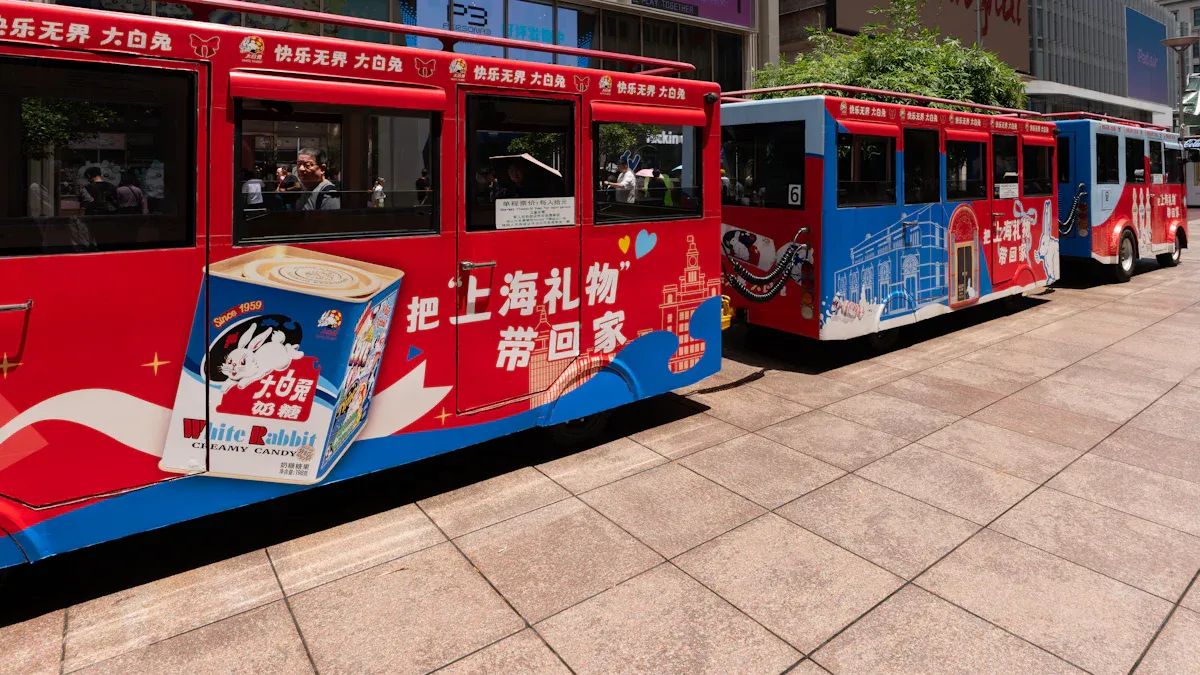
Overview
You see bus advertising every day as you travel through your city. Bus advertising means placing branded visuals on buses. These visuals can be vinyl stickers, full wraps, posters, or even digital screens. When you use bus advertising, you turn a regular bus into a moving billboard. This moving billboard travels through busy streets, neighborhoods, and business districts. It catches the eyes of drivers, pedestrians, and passengers.
Bus advertising is a part of out-of-home advertising. Out-of-home advertising includes any ad you see outside your home, like billboards, posters, and signs. Public transportation advertising is a special type of out-of-home advertising. It uses vehicles like buses, trains, and taxis to show ads to people on the move. Advertisements on buses stand out because they move through many parts of the city. This movement helps your message reach a wide and diverse group of people.
You can use different formats for bus advertising:
Bus wraps cover the whole bus with bright, bold designs. They make the bus look like a giant ad on wheels.
Side panels give you large spaces on the sides of the bus. People walking or driving by can see these ads easily.
Rear panels target people behind the bus, like drivers and cyclists.
Interior cards and posters reach people riding inside the bus. These ads give you a chance to share more details with a captive audience.
Digital displays use LED screens to show changing ads. You can update these ads in real time and even target them to certain locations.
Bus advertising uses high-quality materials like vinyl wraps and digital screens. These materials make your ads look sharp and last for years. Vinyl wraps protect the bus paint and can last up to five years. Digital displays let you show dynamic and interactive ads that grab attention.
How It Works
Bus advertising works by using the mobility of public and private buses. When you place ads on buses, your message travels across the city. Buses follow set routes through neighborhoods, shopping areas, schools, and business districts. This movement lets your ad reach many different people every day.
You can target your ads to certain areas by choosing specific bus routes. For example, you might want your ad to appear on buses that pass by a university or a busy shopping center. Some buses use GPS and digital screens to show location-based ads. If a bus is near a sports stadium, you can show ads for upcoming games or events.
Bus advertising reaches people who might not see ads on TV, radio, or social media.
Commuters spend a lot of time on public transport, often 45 to 60 minutes a day. This gives your ad repeated exposure and helps people remember your brand.
Buses move through different neighborhoods, so your ad gets seen by students, workers, tourists, and shoppers.
Bus advertising stands out from other transit ads like subway posters or taxi wraps. Buses offer more space for creative designs and move through more parts of the city. Unlike digital ads, people cannot skip or mute bus ads. Your message stays visible as long as the bus is on the road.
Bus advertising gives you a cost-effective way to reach a large and varied audience. It works well for both local businesses and big brands. You can use data and technology to track how many people see your ad and adjust your campaign for better results.
Types of Bus Advertising
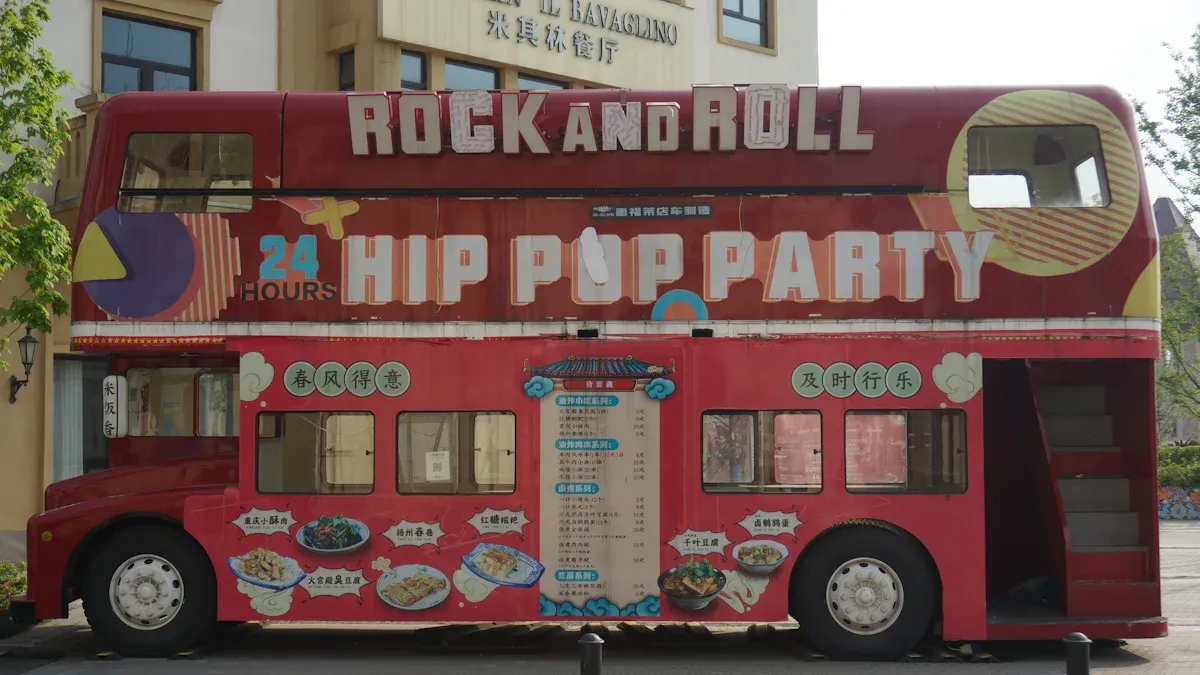
Exterior Bus Advertising
Exterior bus advertising puts ads on the outside of buses. There are a few ways to do this:
Bus wraps cover the whole bus with bright pictures. The bus becomes a moving ad for everyone to see.
Bus side panels use big spaces on the sides of the bus. People walking or driving by can spot these ads easily.
Back panels show ads to drivers and cyclists behind the bus.
Exterior bus ads are easy to see. They work all day and night in busy places. Bus wraps and side panels help your brand get noticed by many people. This kind of advertising helps people remember your brand. They see your ad many times as the bus moves around.
Tip: Exterior bus ads save money. You reach local people often without paying as much as TV or radio.
Interior Bus Advertising
Interior bus advertising shows ads inside the bus. You can use cards, posters, or ads on seat backs. Passengers look around a lot during their ride. This gives your ad more time to be seen. Interior bus ads feel more personal because riders are close to them. People remember these ads better since they see them longer.
You can add more details in these ads. For example, you can put a phone number, website, or a special deal. This works well for local businesses that want to reach people nearby.
Digital Bus Advertising
Digital screens on buses are changing how ads work. These screens show moving ads that can change anytime. You can use GPS to show different ads in different places or times. Some digital ads let people use QR codes or touch the screen. This makes your ad more fun and easy to remember.
Digital bus ads use LED screens for bright messages.
You can change ads for weather, events, or neighborhoods.
Eco-friendly choices like energy-saving lights and recycled materials are getting popular.
Note: Interactive features and mobile links help you reach people on and off the bus. This is becoming more common in 2025.
Launching a Bus Advertising Campaign
Planning
To launch a successful bus advertising campaign, you need a clear plan. Start by identifying your target audience. Think about who will care most about your product or service. Setting goals comes next. Decide if you want to boost sales, increase brand awareness, or promote a special event. Brainstorm creative ideas that fit your goals and look at what has worked for others. Choose the right marketing channels, such as digital ads or social media, to support your bus campaign. Create an offer that encourages people to take action. Make sure you have the resources you need, like designers or marketing experts. Estimate how well your campaign might do by predicting response rates and conversions.
Tip: Brands that want to reach more people often pick longer bus routes, while new brands focus on shorter routes for repeated exposure.
Design
Good design makes your ad stand out. Keep your message simple and focus on one clear idea. Use large, bold fonts so people can read your ad from far away or while the bus moves. Stick to your brand colors and logo for easy recognition. Bright colors and fun images grab attention and help people remember your ad. Add a call to action, like a QR code, so people know what to do next. Work with designers to make sure your ad looks great and matches your campaign goals.
Use fewer than seven words for quick reading.
Add emotional images or quotes to connect with viewers.
Personalize your ad for local neighborhoods when possible.
Placement
Where you place your ad matters. Pick bus routes that pass by busy shopping centers, schools, or your own business. Think about who will see your ad—drivers, pedestrians, or bus riders. Side ads work well for people walking by, while rear ads target drivers behind the bus. Inside ads reach passengers during their ride. You can also advertise on bus shelters or benches for extra exposure. Partner with an outdoor media company to help choose the best routes and placements.
Placement Type | Best For | Example Use |
|---|---|---|
Side Panels | Pedestrians, drivers | Busy downtown streets |
Rear Panels | Drivers, cyclists | Stop-and-go traffic |
Interior Ads | Bus passengers | Heavily used commuter lines |
Full Wraps | Maximum brand impact | Citywide campaigns |
During big events or holidays, placing ads on buses near event locations can boost your campaign’s reach.
Measurement
You need to track your results to see if your campaign works. Set clear goals, like how many people scan your QR code or call your special phone number. Watch for increases in sales or website visits after your ad launches. Use surveys to ask people if they remember seeing your ad. Check social media for mentions of your brand. Try using unique URLs or promo codes to see which ads get the most attention. New tools like geofencing can help you track how many people come near your ad.
For example, a bookstore used QR codes on bus ads to offer discounts. They counted the scans and redemptions to measure new customers.
Transit Advertising Benefits and Costs
Effectiveness
Transit advertising helps many people see your ad often. Your message moves through busy streets and neighborhoods on buses. This means people see your ad many times each day. Drivers, people walking, and bus riders all notice your ad. You cannot skip or block these ads, so they stay in view.
Transit advertising is special because it covers a lot of places. You can reach many different groups, like students, workers, and shoppers. Digital out-of-home ads on buses work even better. People remember these ads and sometimes do something after seeing them.
Here is a table that shows how transit advertising compares to other ads:
Metric | Statistic | Description |
|---|---|---|
Favorable View of DOOH Ads | 73% | More people like digital out-of-home ads than TV, social media, or print. |
Consumer Action After DOOH Exposure | 76% | Most people do something after seeing a digital out-of-home ad. |
Store Visits from Directional DOOH Ads | 51% | Over half visit a store after seeing a directional ad. |
Purchase Rate After Store Visit | 93% | Almost all who visit a store after seeing an ad make a purchase. |
Mobile Device Actions Post-DOOH | 74% | Many use their phones to search or visit websites after seeing an ad. |
Likelihood to Take Action if Ad is Visually Appealing | 80% | Creative and bold ads get more responses. |
Likelihood to Share DOOH Ads | 71% | People share ads they like with friends. |
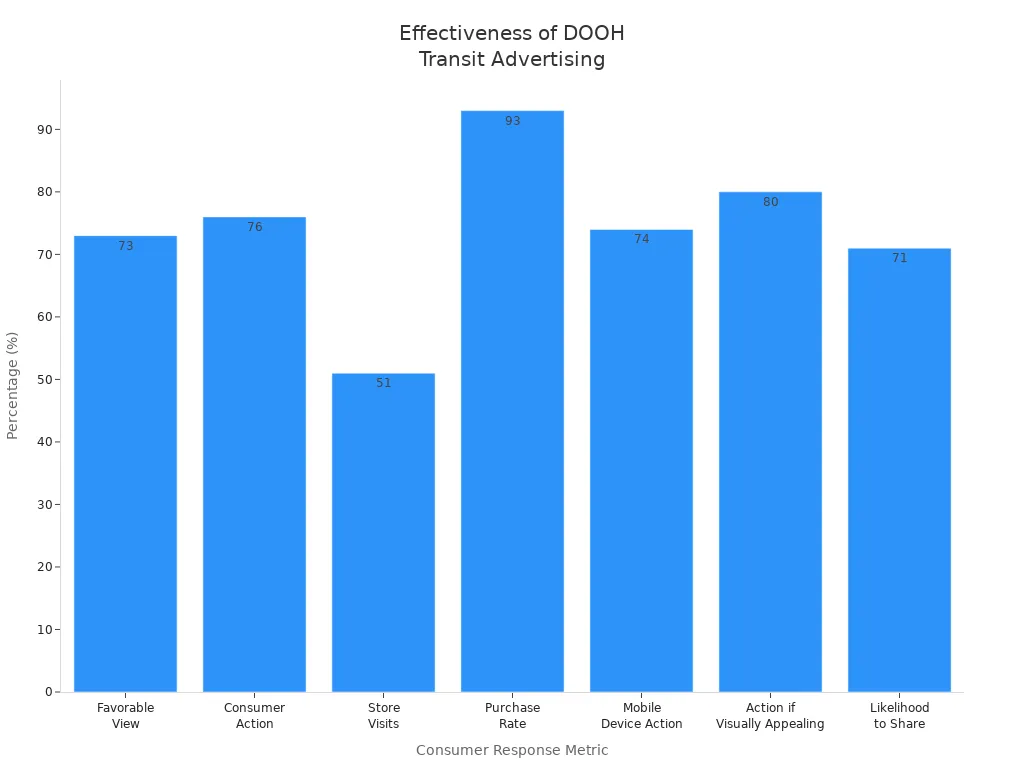
Tip: Transit advertising does not have ad-blockers or skipped content. Your message stays in front of people as they move around the city.
Cost Breakdown
Transit advertising is a good way to save money on ads. You can pick different ad types and places to fit your budget. The price depends on the ad size, where you put it, and how long it runs. Bus advertising gives you choices, from small inside ads to big outside wraps.
Here is a table that shows usual costs for bus ads in 2025:
Advertising Format | Typical Cost Range (per month) | Description/Notes |
|---|---|---|
Full Bus Wraps | $1,200 – $4,500 | Exterior, high brand awareness |
Rear Panels | $400 – $1,200 | Exterior, short message targeting drivers |
Seatback Posters | $80 – $300 | Interior, captive commuter attention |
Digital Screens | $200 – $800 | Interior, real-time content updates |
Handrail Ads | $50 – $150 | Hybrid, affordable with high touch frequency |
Mobile TV Ads | $1,000 – $3,000 | Hybrid, 15-30 second loops across city fleets |
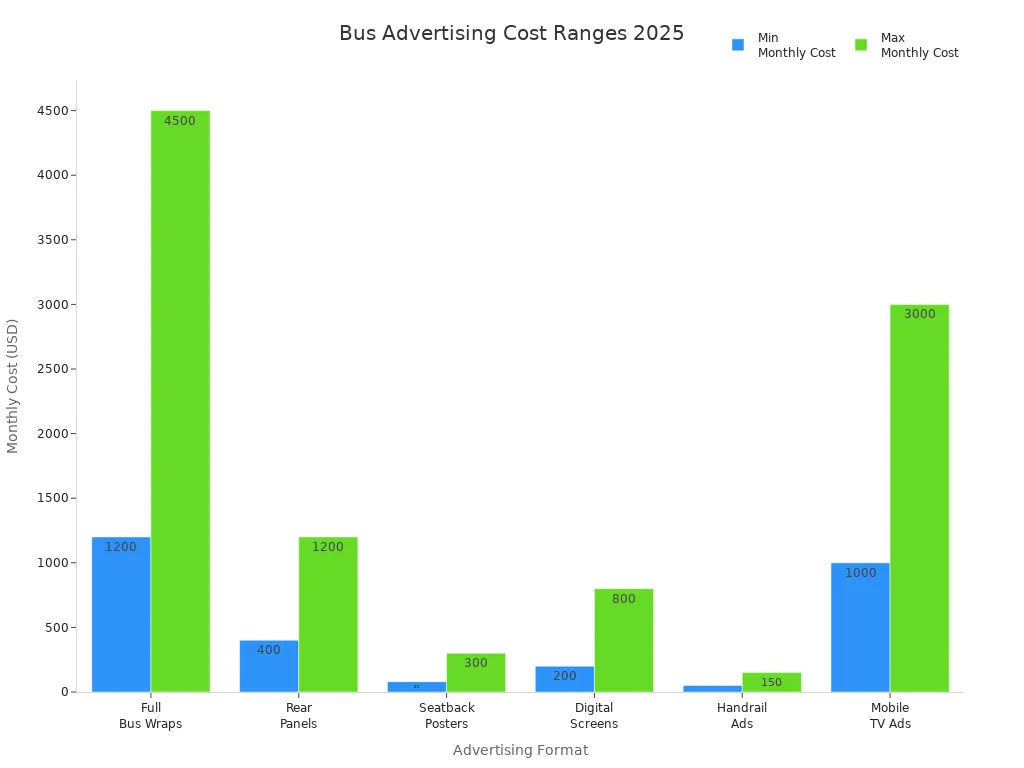
You can also look at other outdoor ad choices:
Advertising Type | Cost Range (per month) | Key Pricing Factors | Targeting Strength |
|---|---|---|---|
Bus Bench Ads | $150 – $1,000 | Location, placement | High hyperlocal precision |
Billboards | $5,000+ (traditional), $15,000+ (digital) | Location, size, visibility | Broad, less precise |
Transit Ads | $2,500 – $10,000 | Ad size, placement, route coverage | Broader geographic coverage |
Kiosks | $500 – $5,000 | Location, digital screen type | Moderate targeting |
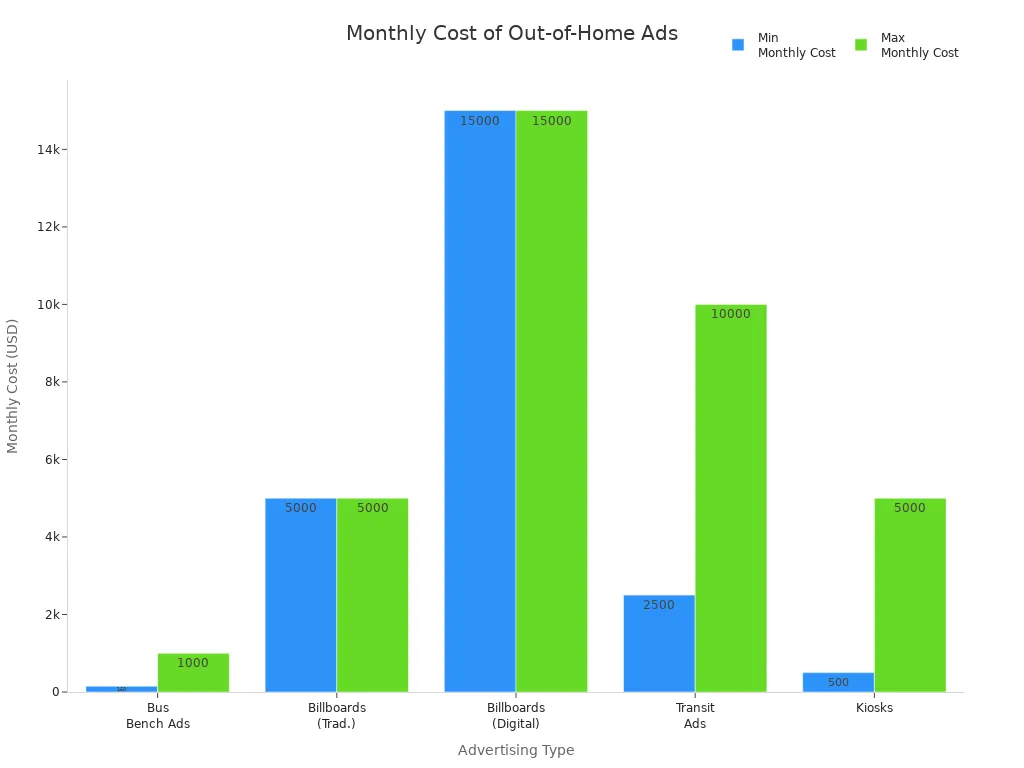
Ads inside buses can cost as little as $25 to $125 each month. Outside ads can be $100 to over $6,000 per month. Full bus wraps cost more because they cover the whole bus and get noticed more. The price changes based on ad size, where you put it, how long it runs, and which bus routes you pick. You can start with a small ad or choose a big one, depending on your goals.
Note: Transit advertising lets you reach lots of people without paying as much as TV or digital billboards.
Real-World Examples
Transit advertising works for many brands, both big and small. You can see results in local and national campaigns. Here are some real examples:
Case Study | Campaign Description | Measurable Results / Impact |
|---|---|---|
Local Beverage Brand | Six-month bus stop advertising campaign. | 40% increase in spontaneous brand recall; 15% higher customer lifetime value among exposed consumers. |
Healthcare Provider | Bus stop ads with QR codes linking to digital resources. | Higher patient retention and engagement among those who scanned QR codes. |
Campaign / Brand | Description of Bus Advertising Campaign | Measurable Results / Impact |
|---|---|---|
Specsavers | Creative bus design that looks like the bus backed into a signpost, reminding people about eye health. | Memorable and attention-grabbing, encouraging health check-ups. |
Unilever (All detergent) | Bus covered with 32 loads of stained laundry to show cleaning power in NYC. | Made people curious and got them talking about the product. |
Tiernitos Dog Food | Picture of a dog pulling its owner, printed on the bus side, showing excitement for the product. | Made people laugh and helped dog owners remember the brand. |
Anti-Smoking Campaign | Image of a bald man blowing out real smoke on bus ads to show tobacco harm. | Reached many people with a strong public health message. |
Copenhagen Zoo | Bus wrapped with a big picture of a snake, making it look like a snake is around the bus. | Very eye-catching and made more people know about the zoo. |
Netflix (Stranger Things) | Whole bus turned into a giant ad for the show. | Got lots of attention and made the show more popular. |
Snickers | Man chasing a bus with a candy bar hanging out, showing craving in a funny way. | Made people smile and remember the brand’s message. |
When you use transit advertising, you can make ads that people talk about. You can help people remember your brand, get more store visits, and even sell more. Creative ads and smart placements help your message stand out in the city.
Public Transportation Advertising Trends 2025
Targeting
You can now reach people more exactly than before. In 2025, bus advertising uses new targeting tools. Advertisers pick routes that fit the age or interests of their customers. You can show ads in certain neighborhoods or near busy places like malls. Digital screens on buses let you change ads for the time, weather, or events.
Demographic targeting helps you reach people by age or income.
Geographic targeting lets you pick bus routes in key areas.
Scheduling tools help you run ads when people are most active.
Frequency capping stops people from seeing the same ad too much.
Audience exclusions keep ads from people who already bought your product.
Smart targeting helps your ads reach the right people at the best time.
Innovations
Bus advertising in 2025 is very different from before. Digital screens have replaced many old posters. These screens show videos, moving pictures, and interactive content. You can use AI to make ads for different groups. For example, a rainy day can show an umbrella ad. Augmented reality lets people scan a bus ad and see 3D images or deals.
Digital displays use real-time data to update ads fast.
AI-powered personalization changes messages for each place and group.
AR features make fun, interactive experiences that keep people interested.
QR codes and NFC tags help people connect with your brand on their phones.
Eco-friendly materials and LED screens help protect the environment.
Many cities use ad money to support electric buses and green projects. Your campaign can help make the city cleaner.
Tips for Success
You can get better results from your bus ads by following these tips:
Target your audience by place, age, or interests for better results.
Pick the right ad type—use wraps for big impact or digital screens for more choices.
Keep your design simple, bold, and easy to read.
Use interactive features like QR codes or AR to get more people involved.
Try different messages and track results with web tools or promo codes.
Choose eco-friendly options to show your brand cares about the planet.
Work with transit partners to find the best routes and times for your ads.
Best Practice | Why It Works |
|---|---|
Clear visuals | Easy to see and remember |
Geo-targeting | Reaches the right people |
Interactive content | Gets more people to join in and share |
Eco-friendly design | Helps the planet and your reputation |
When you use these tips, your bus ads will stand out and work well in 2025.
Bus advertising gives you a smart way to reach many people in 2025. You can target neighborhoods, use large ad spaces, and reach riders from all walks of life.
Buses move through busy areas, so your ad gets seen by students, workers, and families.
Ads stay visible longer than digital or static billboards.
You can use wraps, panels, or interior ads to fit your brand’s needs.
QR codes and data tools help you track results and connect with customers.
You can work with groups like Event Transportation Systems or local transit agencies to launch your campaign. These partners offer design, placement, and even video content services. Community-based strategies, such as in-kind ad swaps or sponsorships, also help you get started and build local support.
FAQ
How long does it take to launch a bus advertising campaign?
You can usually launch a bus advertising campaign in two to four weeks. This time includes planning, design, and getting approval from the transit company.
Can you change your ad during the campaign?
Yes, you can update your ad. Digital screens let you change messages quickly. For printed ads, you need to print and install new materials.
Who designs the bus ads?
You can hire a professional designer or use the ad agency’s team. Some transit companies offer design help. Make sure your ad follows the company’s rules.
How do you know if your bus ad works?
You can track results with QR codes, special phone numbers, or promo codes. You can also check website visits and sales after your ad starts.
See Also
Experience The Future With AI Box CarPlay In 2025
Best AI Video Boxes For Vehicles Evaluated In 2025
Reviewing The Best CarPlay Adapters For 2023 Ford F-150
How G37 Apple CarPlay Adapters Transform Your Driving Experience
